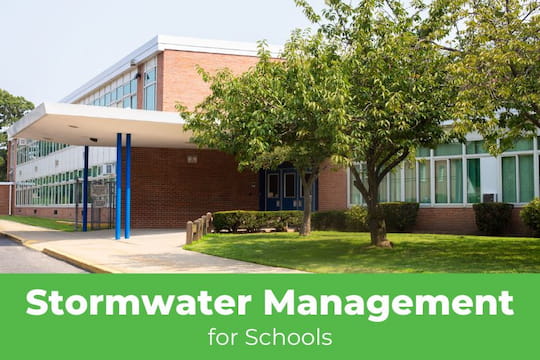As concerns about environmental sustainability continue to grow, the role of schools in implementing eco-friendly practices becomes increasingly pivotal. Schools can make a significant impact by embracing innovative types of stormwater management on campus and using them as teaching opportunities.
By adopting progressive design strategies and engaging the school community, these institutions can do their part to mitigate environmental risks while also growing and nurturing a culture of stewardship and responsibility among their students, staff, and other stakeholders. Innovative ways to manage stormwater can also increase student safety, provide more efficient system maintenance, and potentially reduce stormwater management costs over time. The following ideas provide some useful starting points.
Integrate Green into School Buildings

Green roofs present an innovative solution in stormwater management for schools. This technique involves laying a waterproof membrane on flat roofs and adding layers of drainage filters, growing medium, soil, and plants. Older buildings can be retrofitted to accommodate green roofs, enhancing functionality and aesthetics. These roofs capture and filter stormwater and offer additional building insulation, which reduces energy costs and provides other environmental benefits.
Green roofs retain snow in snowy climates, which mitigates runoff and prevents ice dams. Adding vegetation to the unused space on roofs also improves air quality and has a cooling effect during hot weather. In urban settings, green roofs significantly reduce the urban heat island effect, mitigating the impact of climate change.
Additionally, green roofs dampen noise from overhead aircraft, creating a quieter learning environment for students. They also serve as habitats for birds and insects, promoting biodiversity and ecological balance. Schools address stormwater challenges by turning flat roofs into green spaces, enhancing sustainability, and creating multifunctional outdoor areas conducive to learning and environmental appreciation.
Playground Design
To enhance school stormwater management, playgrounds can use materials such as permeable concrete and rubberized woodchips to allow rainwater to soak in and reduce runoff. Around playground areas, integrating features like vegetated bioswales can help to naturally filter and absorb runoff while adding visual interest to the school property and additional habitat for local wildlife.
Additionally, strategically placing trees in the playground design offers shade and aesthetics and aids in stormwater absorption through their root systems, contributing to overall water retention and soil stability.
Reducing Parking Pollution
Parking lots generate significant amounts of pollutants, which can accumulate and enter storm drains if not managed effectively. Daily activities such as pick-ups, drop-offs, teacher and student parking, and school buses leave pollutants like engine oil, grease, and other chemicals on school grounds. Recent air-quality campaigns now advocate for reduced car idling on school premises to enhance air quality. Similarly, campaigns promoting green design aim to minimize parking lot runoff, reducing downstream pollution and flooding risks.
Integrating planter boxes around campus and parking areas for schools with limited space can create rain gardens, effectively collecting and filtering rainwater from roofs, parking lots, and sidewalks. On larger campuses, implementing bioswales around parking lots can be highly effective. These bioswales, containing vegetation, mulch, or native slow-growing plants, capture rainwater and allow it to infiltrate the soil and recharge local groundwater stores.
Planting more trees on school properties is an additional way to reduce stormwater runoff and pollution significantly. Trees form canopies that capture rainwater, slowing its flow and enabling it to evaporate or soak into the ground, thereby minimizing runoff from the property. Restoring trees, often cleared during school construction, represents a proactive step towards sustainable stormwater management practices. These visible stormwater management features can double as an educational tool, enhancing students' understanding of water conservation and pollution prevention.
Regular System Maintenance

While regular maintenance might not seem innovative, engaging in a routine maintenance program is crucial to keep students safer and ensure all stormwater system components remain in good working order and repair. Catch basins are one of the system's most critical components, as they detain sediment, trash, pollutants, and debris before they can enter the school property’s drainage system. A good routine maintenance program is also designed to ensure the long-term effectiveness of the school’s stormwater management measures.
This requires comprehensive maintenance plans considering replacements, upgrades, and more to accommodate issues such as aging and climate change. Regular upkeep activities such as sediment removal, vegetation management, and infrastructure repairs are essential. Regular sediment and debris removal from catch basins and filtration systems helps maintain their capacity and efficiency in capturing pollutants and managing runoff. Proper vegetation management involves pruning, replanting, and weed control to maintain the effectiveness of green infrastructure like bioswales and rain gardens.
Routine maintenance should also include periodic inspections and repairs to infrastructure such as drainage pipes, permeable pavement, and green roofs to address any wear and tear promptly. Neglecting maintenance can lead to clogging, structural damage, reduced performance, and outcomes such as flooding. Neglecting maintenance undermines the effectiveness of stormwater management efforts. By prioritizing long-term maintenance, schools can uphold the integrity of their stormwater systems, prolong their lifespan, and continue reaping the environmental and safety benefits they offer.
Regulatory Compliance
Adhering to regulations regarding the quality of runoff from school premises is imperative. Failure to comply with the relevant regulations may lead to fines and penalties if polluted water enters local water bodies. Given the evolving regulatory landscape, keeping up with compliance requirements can be challenging, particularly depending on the school's existing staffing, workload, and expertise level.
Contracting out this stormwater management component for schools, partially or wholly, proves effective for many commercial properties, including educational facilities. Stormwater management companies handle stormwater drainage problems for associations, municipalities, business complexes, and schools. Their dedicated staff stays updated on regulatory issues and possesses the expertise to navigate compliance complexities.
Moreover, they can liaise with schools and municipalities, facilitating communication and collaboration to ensure regulatory compliance. Outsourcing stormwater management tasks alleviates the burden on school staff, allowing the focus to remain on core educational responsibilities while ensuring adherence to environmental regulations. This proactive approach safeguards against potential fines and promotes environmental stewardship within the school community.
Engaging Students and the Community

Stormwater management initiatives present valuable opportunities for schools to engage with their communities. By involving parents, teachers, students, and local organizations in the planning and implementation such projects, schools can increase students’ environmental stewardship and awareness. For instance, science teachers can integrate projects into their curriculum that educate students on creating permeable pavement. Through hands-on learning, students learn the practicalities of permeable surfaces and the significance of minimizing impermeable areas like parking lots, buildings, and cement walkways.
Furthermore, collaboration with local organizations can enhance community involvement. Partnering with environmental groups or municipal agencies can provide expertise, resources, and additional educational opportunities. Community engagement can extend beyond the school grounds through outreach events, workshops, or educational campaigns to raise awareness about stormwater management and its environmental benefits. By actively involving students and the community in stormwater solutions, schools address environmental challenges and cultivate a sense of responsibility and stewardship among the younger generation. This collaborative approach fosters a deeper understanding of sustainability and encourages active participation in preserving the local environment.
Managing Stormwater Is a Learning Opportunity
Now is the time for schools to take proactive steps towards sustainable stormwater management. By embracing innovative approaches and incorporating features such as bioswales, green roofs, and permeable pavement on campuses, educational institutions can reduce pollution and flooding risks and create valuable learning opportunities for students. School personnel and students can work together to transform school campuses into models of environmental stewardship, ensuring a brighter, greener future for generations to come. Catch basin cleaning is an important step. Contact CatchAll Environmental to see how we can help on your journey towards sustainable stormwater management.












.jpg)


